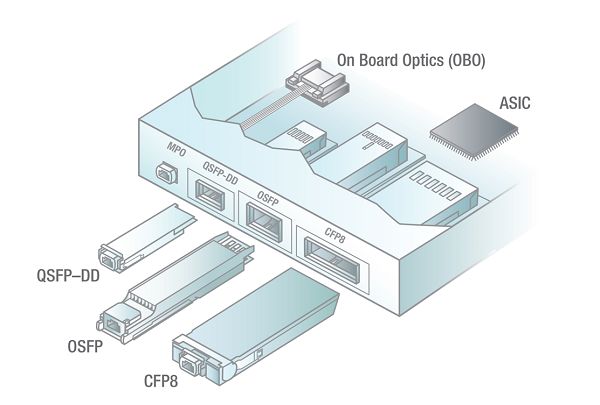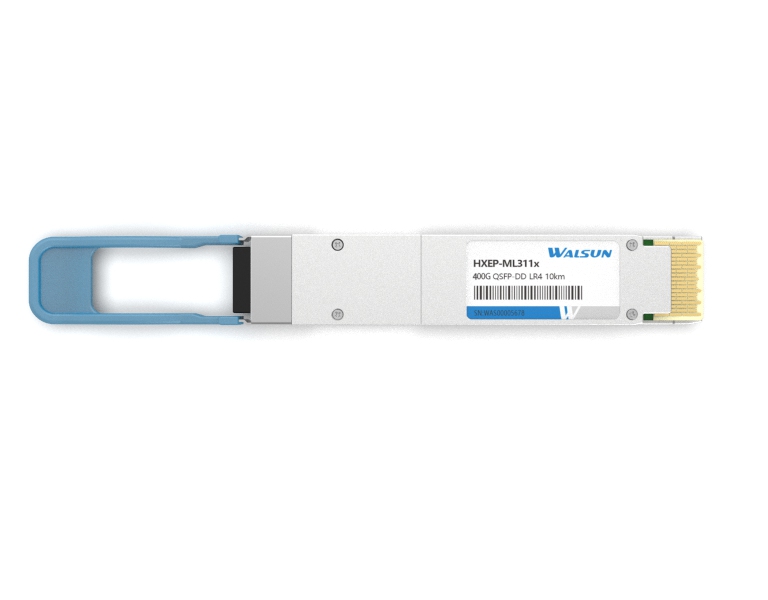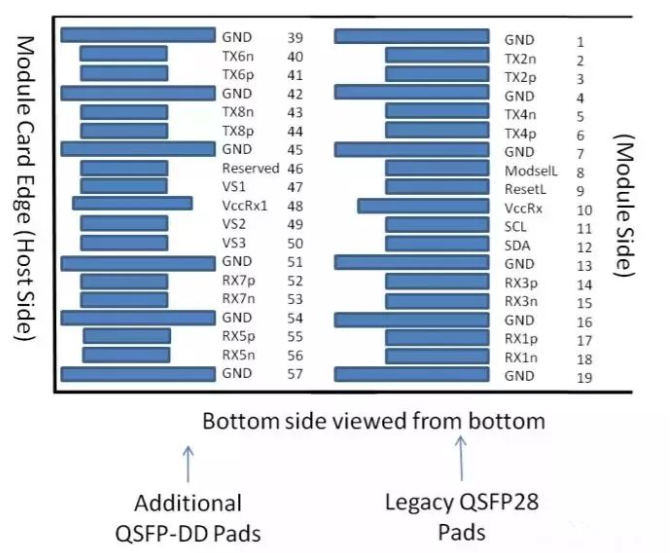

 Knowledge Base +
Knowledge Base +  2024.01.26
2024.01.26400G optical module and 400G optical module research has gradually become the industry hotspot, many optical module manufacturers have stated that they want to step up research and development to seize the 400G optical module market. Cisco, Finisar, etc. have also predicted that the inevitable choice for the next generation of data centers will be 400G optical modules. Today, WMT will talk about the 6 package types of 400G optical modules.

(▲3 types of 400G optical module packaging type comparison chart)
QSFP-DD
The full name of QSFP-DD is Quad Small Form Factor Pluggable-Double Density, Q refers to "Quad", the meaning of 4-way, DD refers to "Double Density". DD means "Double Density". This solution is an expansion of the QSFP by adding one more row to the original 4-channel interface to make it 8-channel, also known as double density. this solution is compatible with the QSFP solution, which is one of the main advantages of this solution. The original QSFP28 module can still be used, just insert another module. The schematic diagram is as follows:
_1706236359.jpg)
(▲QSFP-DD optical module schematic)

Due to the addition of 4 channels, the pins of its electrical interfaces on the top and bottom sides are increased by one row, as shown in the following figure. The left row of pins in the figure below is the newly added pad pins.

(▲QSFP-DD optical module electrical interface pins)
OSFP
The full English name of OSFP is Octal Small Formfactor Pluggable, Octal means octal, which means OSFP optical module uses eight 56G channels to realize 400GbE. 56GbE signals are formed by the 25G DML laser in the modulation of PAM4. This standard is a new interface standard and is not compatible with existing optoelectronic interfaces. Its structure is schematically shown below:
_1706236457.jpg)
(▲OSFP structure schematic)
_1706236479.jpg)
(▲OSFP optical module)
OSFP has its own heat sink, its size is 100.4*22.58*13 mm^3, which is much smaller than CFP8, and the power consumption is relatively low, maximum only 15 W. It is slightly larger than the size of QSFP-DD, and thus requires a larger area of PCB. the pins of its electrical interface are different from QSFP-DD, and there is a row of each on the top and bottom, as shown in the figure below:
_1706236497.jpg)
(▲ OSFP optical module electrical interface pins)
CWDM8
CWDM8 is an extension of the CWDM4 standard, the rate of each wavelength is 50G, and can also realize 400G. its wavelength is defined as follows:
_1706236511.jpg)
(▲ wavelength definition)
Four new center wavelengths are added, i.e., 1351/1371/1391/1411 nm. the wavelength range becomes wider, the requirements for Mux/DeMux are higher, and the number of lasers is doubled. The maximum input power is 8.5dBm. WTT is now able to provide 400G CWDM4 optical module products, as shown in the figure below:
_1706236680.jpg)
(▲ 400G CWDM4 optical module)
CFP8
CFP8 is the expansion of CFP4, the number of channels increased to 8 channels, the size of the corresponding increase, 40 * 102 * 9.5 mm^3, as shown in the figure below:
_1706236701.jpg)
(▲CFP8 optical module)
The cost of this solution is higher, you need to use 16 25G lasers, or use a PLC splitter to reduce the number of lasers, but the LOSS of the splitter is too high, which directly leads to the laser's emitted power is relatively high, and thus the cost will also be high. Power consumption is also higher, the panel interface density is too low.
V. CDFP
CDFP standard was born earlier, so far has been released in the third version of the specification. CD said 400 (Roman numerals). The use of 16 channels, a single channel rate of 25G. due to the number of channels, the size is relatively large.
_1706236719.jpg)
(▲ CDFP optical module)
COBO
COBO's full name is consortium for on board optics, that is, all the optical components placed on the PCB board, no longer limited by the density of the front panel interface restrictions. At the same time, the heat dissipation problem can be reused PCB board between the powerful heat sink can be greatly alleviated. The main advantages of this program are good heat dissipation and small size. However, because it is not hot-swappable, once a module failure, maintenance is more troublesome, very inconvenient.
_1706236734.jpg)
(▲COBO optical module)
At present, 400G optical modules are still in the development and improvement, but from the article we can see that this packaging form of QSFP-DD has obvious advantages in 400G optical modules. Ultimately, which packaging form to become the mainstream packaging form of 400G optical module is still to be time and market test.
Additional Learning Hub Resources
Cisco 400G QSFP-DD Optical Transceivers Overview
800G OSFP Optical Transceiver Module Overview
What is the maximum data rate for QSFP transceiver?
What are the types of QSFP transceivers
What is the biggest difference between SFP, SFP+, SFP28, QSFP+, QSFP28, QSFP-DD, and OSFP?
Subscribe to the newsletter
for all the latest updates.
2-5# Building, Tongfuyu Industrial Zone, Aiqun Road, Shiyan Street, Baoan District, Shenzhen. China
